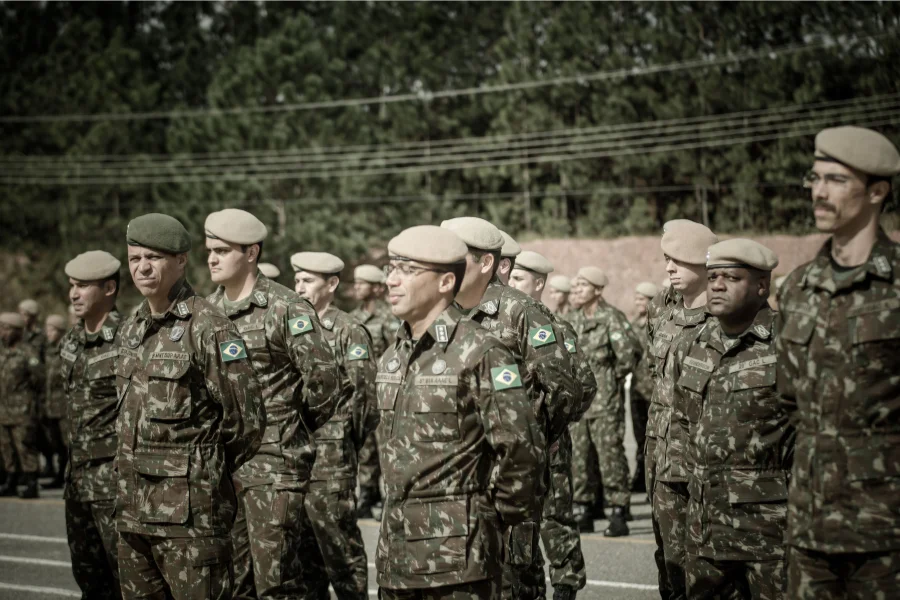A Guide to Understanding and Decoding the ACFT Score Chart
This article takes a deep dive into the ACFT score chart-a question that, while vital for military personnel, is often shrouded in complexity. If you’re here, you’re likely looking for more than just numbers and charts. You don’t just want to pass; you want to excel and understand how each point impacts your career and personal fitness routine.
Taking the ACFT can be a challenging but rewarding experience. Beyond the sweat and determination lies the score chart-an essential component that can prove just as challenging. In the military, the ACFT isn’t just another fitness test; it’s a test that demonstrates your readiness for the demands of military life. It’s a test that has become more than just random numbers on a page.
You’ll learn about areas often overlooked as we unpack and analyze the ACFT score chart. Whether you’re a veteran military member, a reservist juggling civilian life with military service commitments, or a fitness enthusiast intrigued by the military’s standards, this guide is for you. There will be a discussion of minimum scores, how these scores are used to earn promotion points, and what an average score actually means. The ACFT scores will also be compared to more familiar systems like the SAT, providing a unique perspective linking the military and civilian worlds.
The following image shows the detailed scoring chart, categorizing performance by age and gender. This visualization will help you set realistic fitness goals and target your training. The full ACFT grading scales can be viewed and downloaded here for a comprehensive overview and to help you prepare for the test.
We want to empower you with knowledge, enabling you to not only meet but surpass expectations, turning a daunting task into a stepping stone to success as we guide you through the ACFT score chart.
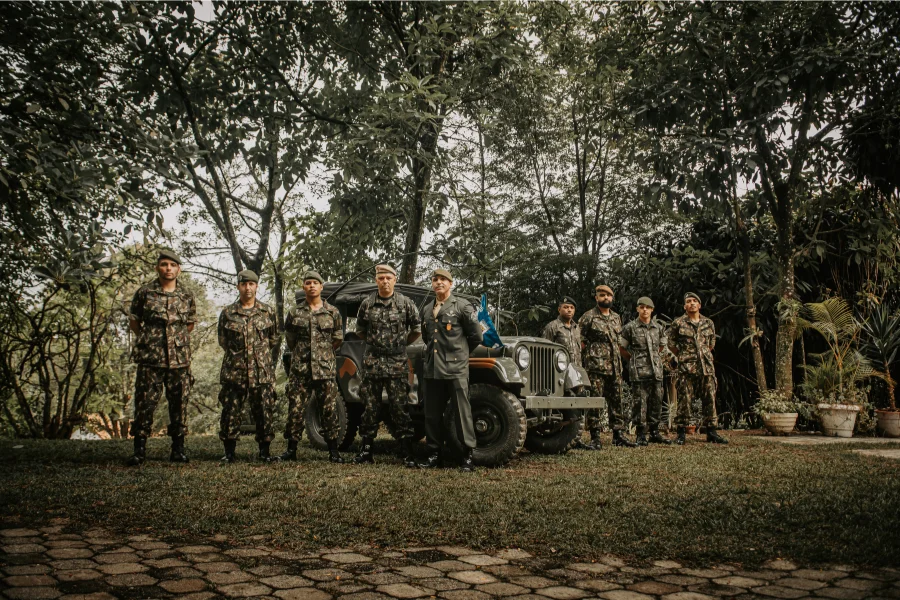
Explaining the ACFT Scoring System
A good understanding of the ACFT scoring system is crucial not only for passing the test, but also for excelling. The ACFT demands a multifaceted approach to fitness readiness, which is reflected in its scoring. We’re going to demystify this system so you can achieve these standards not only efficiently, but also effectively.
The ACFT is scored in what way?
It consists of six events with a maximum score of 100 points each, adding up to 600 overall points. Each event assesses different aspects of physical fitness, including strength, endurance, and agility. Age and gender are taken into account when adjusting scores, to ensure a fair assessment for all.
Requirements for Minimum Scores
It is critical to understand the minimum score required to pass the ACFT, which is 60 points out of 600, according to the University of Portland Army ROTC. In spite of this, those who are serious about their military careers do not usually aim to meet the bare minimum. By striving for higher scores, you showcase not only your physical abilities but also your dedication and resilience – qualities highly valued by military personnel.
The Importance of Scoring Well
By scoring well on the ACFT, you push yourself to new limits, setting new personal benchmarks. A higher score can be the key to career progression and new military opportunities. A military officer’s ACFT score is a significant factor in his or her professional military profile because physical fitness is often seen as a metaphor for readiness and capability.
Age-related scoring
A level playing field is ensured for participants of all ages with the ACFT scoring system, which takes into account the physical abilities of individuals as they age. It is important to know where you rank in your age group in order to tailor your training regimen in order to maximize your scores.
Gender and Scoring
This approach promotes equity, allowing all soldiers to be evaluated fairly based on their physical capabilities by including gender-specific standards.
Performing the Army Fitness Test (AFT) according to Army Fitness Test Event Execution Standards With ACFT Score Chart
3-Repetition Maximum Deadlift
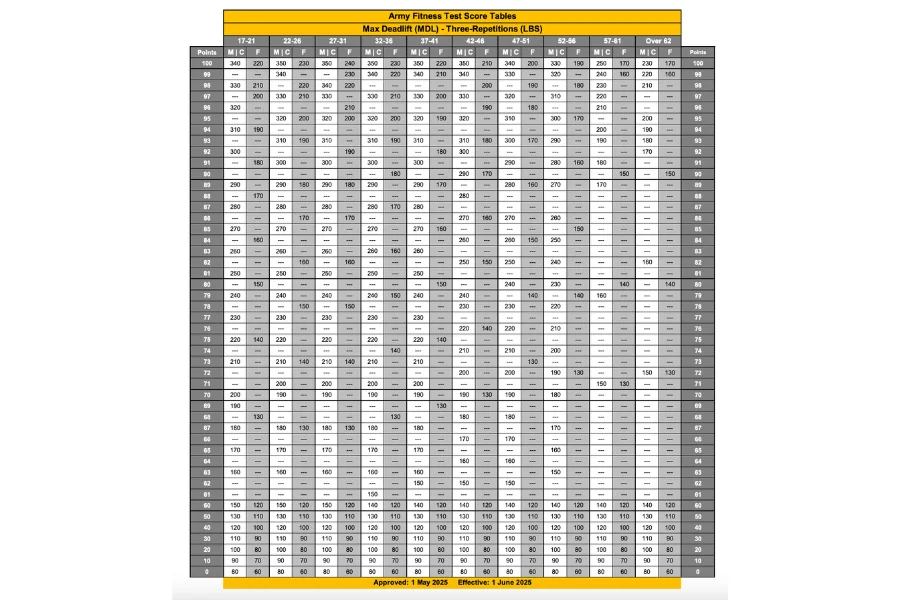
Phase 1: Preparation
- In response to the order “GET SET,” the soldier:
- Footsteps inside the hex bar, shoulder width apart
- Determines the mid-point of the handles on the hex bars
- A knee bend and a hip bend
- Closely grasps the handles at the center
- Ensure that the arms are fully extended and the back is flat
- A slight extension or alignment of the head with the spine
- Ground contact is maintained with heels
This is the position from which each repetition begins.
Phase 2: Movement upwards
- In response to the command “GO,” the Soldier:
- In order to reach a Straddle Stance, straighten the hips and knees and lift the bar.
- Make sure the hips are not higher than the shoulders or before them
- Straightens the back – does not bend it or round it out
- Ensures that feet remain in the same position
- Maintains balance and control throughout the movement
Phase 3: Moving downward
- When the Soldier reaches the Straddle Stance position, he:
- Controls the bar’s descent back to the ground
- Ensures that the back is straight
- Lays the bar on the ground (does not drop it)
- Completes repetitions by touching the weight plates to the ground
The rules of the attempt
- Repeat this exercise three times with the same weight
- A Soldier who fails to complete three continuous repetitions under control is subject to the following consequences:
- The weight of the retest was lowered one time
- In the event that the Soldier is successful in completing three repetitions on the first attempt:
- It is possible to attempt a higher weight an additional time
- It is possible to attempt the MDL two times
Hand-Release Push-Up
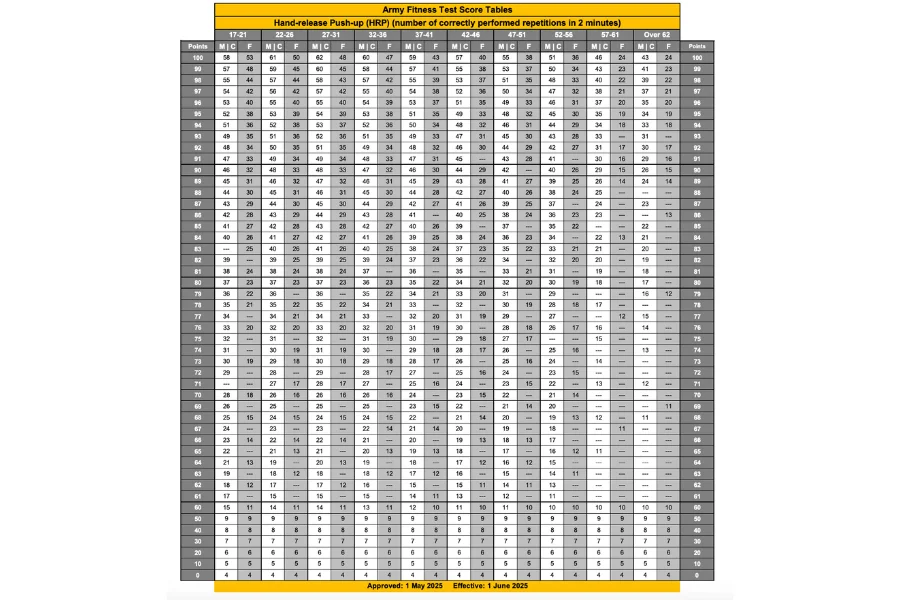
Position at the beginning
- The Soldier responded to the command “GET SET” by:
- Faces the start line in a prone position
- Lie flat on the ground with hands flat
- Place index fingers inside the shoulder’s outer edges
- On the ground, place the chest, the front of the hips, and the thighs
- Puts both feet on the ground at the same time or about the width of a boot apart, touching toes to the ground
- A ankle is flexed
- It is not necessary to place the head on the ground
- Makes sure feet are generally together (no more than a boot’s width apart) while running
- During the event, feet may be adjusted so long as they do not lift a foot
1st movement
- The soldier responded to the command “GO” by:
- Activates their whole body to push themselves up from the ground
- Leans forward while fully extending the elbows
- Keeps the entire body aligned from head to ankles
- It is important that this generally straight position is maintained throughout the HRP
- Failure to maintain general alignment during a repetition will result in the repetition not counting
- During the rest position, knees, hips, trunks, or necks may not be bent or flexed.
2nd movement
- When the soldier reaches the up position, he:
- The body is lowered to the ground by bending the elbows
- Ensures chest, hips, and thighs touch down simultaneously
- It is not necessary to touch the ground with the head or face
3rd Movement
- When the hand is released – without moving the head, body, or legs – the Soldier:
- In the T position, extend both arms straight out to the side until arms are generally straight out to the side.
- During this movement, the hands and arms may touch the ground or slide along it
4th Movement
- According to the soldier:
- Returns hands to the ground immediately to begin again
- Repeats the process
Sprint-Drag-Carry
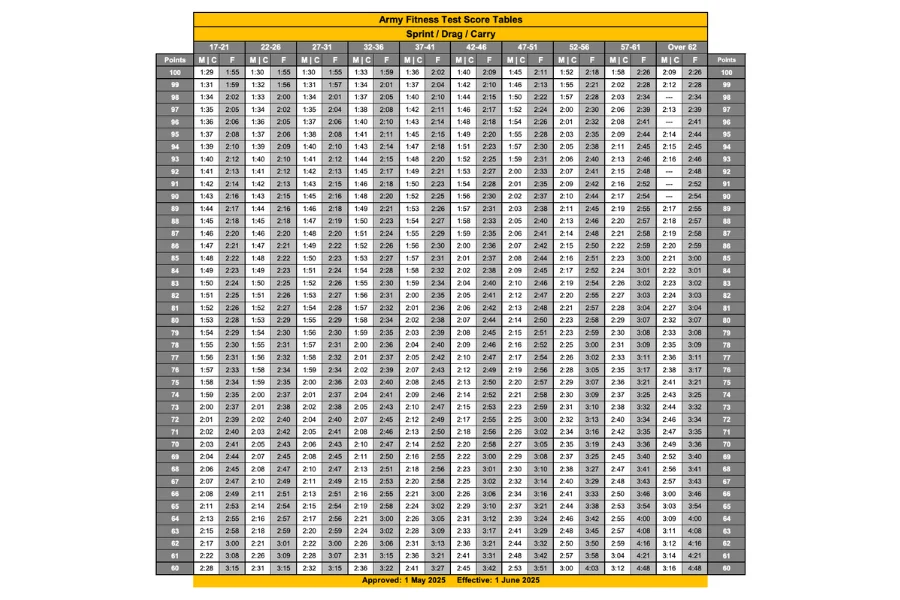
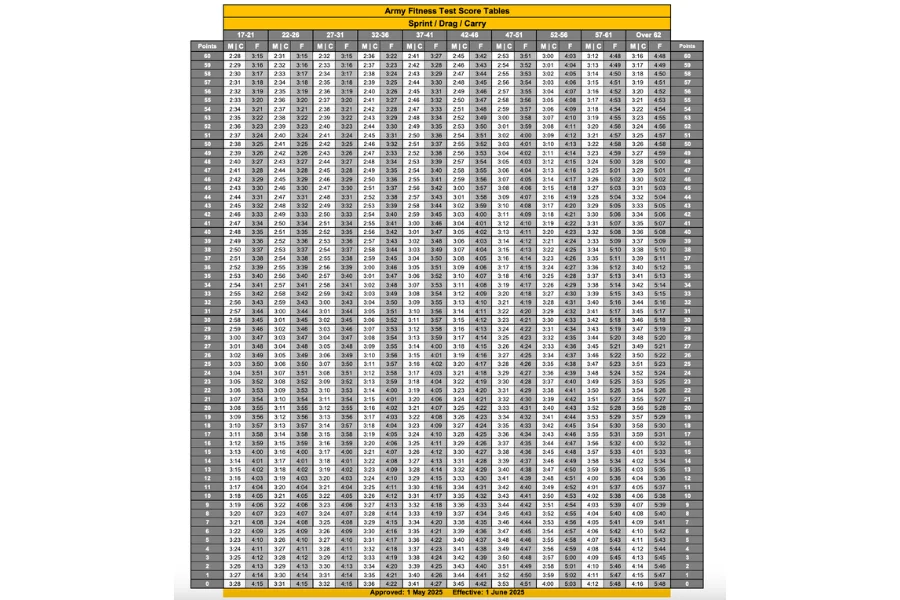
Position at the beginning
- In response to the command “GET SET,” the soldier:
- The head should be behind the start line in the prone position
- Graders are positioned to view both the start line and the 25m line. Soldiers or battle buddies can be positioned on the 25m line to ensure test event compliance.
The sprint
- The soldier responded to the command “GO” by:
- Sprints 25 meters while standing
- Touches the 25m line with both feet and hands
- Returns to the starting line and sprints
- In the event that the Soldier fails to touch the 25m line with hand and foot, the grader watching the 25m turn line will call them back.
The drag
- As told by the soldier:
- Places a hand on each strap handle, positioned behind the starting line and resting on the sled
- The entire sled must cross the 25m line by pulling it backwards
- Once the sled has crossed the start line, it must be turned around and pulled back.
- It is important to note that if the entire sled does not cross the 25m line or start line, the grader watching the 25m turn line will call them back.
The lateral
- Upon crossing the start line, the Soldier:
- A 25m lateral is performed
- With foot and hand, touches 25m turn line
- Returns to the start line by performing a lateral movement
- Returns to the start line after 25m and leads each step back to the start line
- Soldiers who fail to touch the 25m turn line with both hands and feet will be called back by the grader watching the line
- It is important to note that graders will correct soldiers if their feet cross
The carry
- According to the soldier:
- Holds the 40-pound kettlebells in both hands
- A 25-meter turn line is reached
- Make a 25m turn with one foot
- Returns to the starting point after turning around
- Should the soldier drop the kettlebells while moving, the carry will resume from the point where the kettlebells were dropped
- In the event that the Soldier does not touch the 25m turn line with their foot, the grader watching the 25m turn line will call them back to the 25m turn line
In a sprint
- When the Soldier steps onto/over the starting line, he/she:
- Puts the kettlebells on the ground
- Sprints and turns 25 meters
- Using both feet and hands, touches the 25m turn line
- Returns to the starting line and sprints
- Soldiers who fail to touch the 25m turn line with both hands and feet will be called back by the grader watching the line
- As soon as the Soldier crosses the start line after the final sprint (250 meters), the time is stopped.
Plank
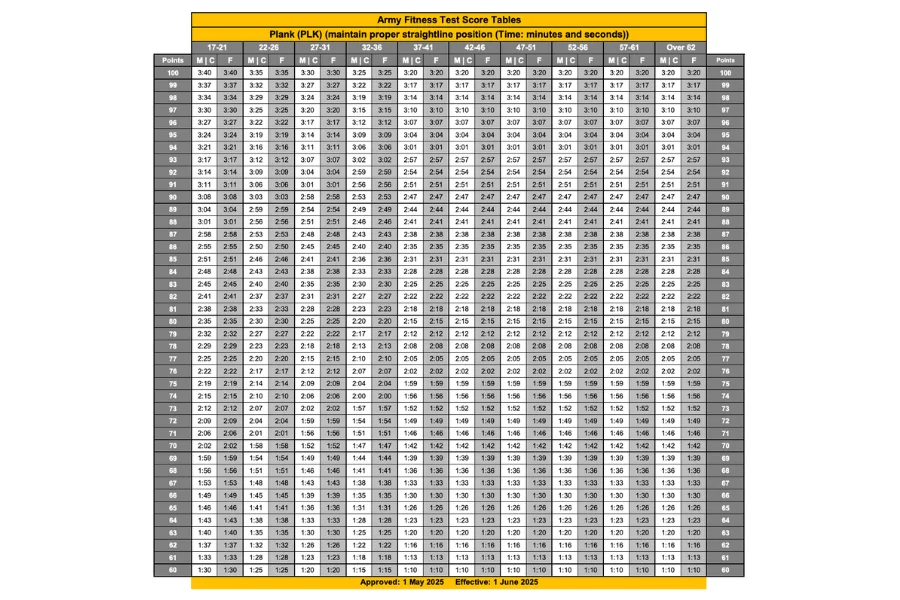
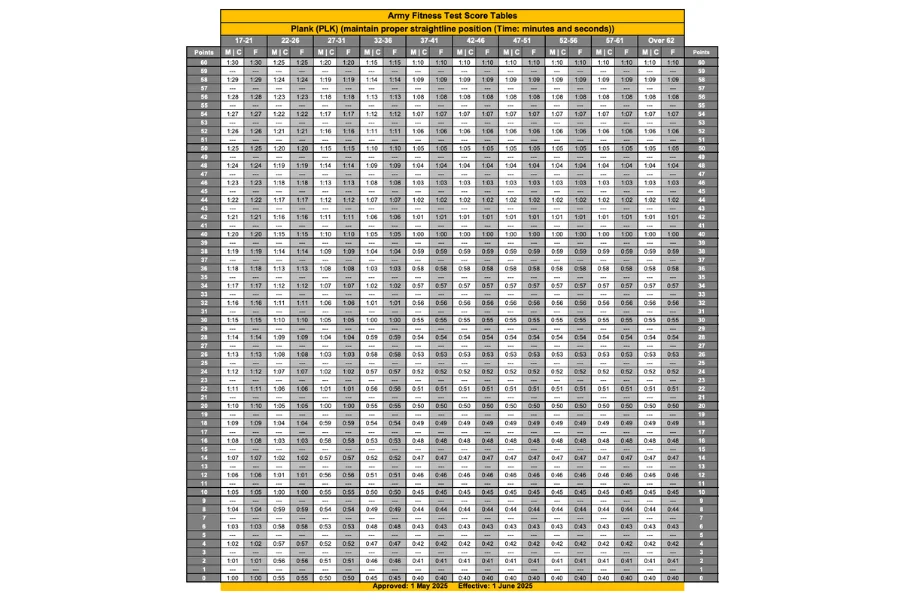
Position at the beginning
- “GET READY” was given to the soldier, and he replied as follows:
- Places hands on the ground in either of the following ways:
- Holding hands in fists with the pinky side touching the ground, or
- Lie flat on your back with your palms down
- Keep hands no wider apart than the grader’s fist
- In a triangle shape, bend elbows aligned with shoulders, forearms flat on the ground
- Rests one or both knees on the ground while bending the hips
- Places hands on the ground in either of the following ways:
The execution
- The soldier responded to the command “GET SET” by:
- Kneel on both knees
- Ensures that the hips, legs, shoulders, and head are all in a straight line
- It is similar to the “Front Leaning Rest” in that it focuses the eyes on the ground.
- It is possible to have feet that are as far apart as a grader’s boot width
- Creates a triangle with the forearms and elbows by aligning them with the shoulders
- The bottom of the toes are on the ground as the ankles are flexed
- Straightens the body from head to ankles
- A boot width should be the distance between the fingers on the left hand and those on the right hand. Fingers cannot be interlocked, interlaced, or touching each other.
- The soldier responded to the command “GO” by:
- Places the plank in the proper position
- Make sure that your shoulders, back, hips, and legs remain in a straight line throughout the event
- Throughout the event, keep your feet, forearms, and fists/palms on the ground
- As long as the hands remain on the ground, Soldiers may change hand position from fists-pinky side down to palms down
Rules for terminating
- In order to terminate the Plank event, the Soldier must:
- Uses any part of the body other than the feet, forearms, fists, or palms to touch the ground
- Lifts a hand or foot off the ground
- Head-to-toe position is not straight
- The students will:
- To correct failures to maintain plank position or slipping hands/feet, give one verbal warning
- The Soldier’s performance should be terminated if he is incapable of correcting a deficiency or maintaining proper plank position
If you are in the correct plank position, you are allowed to shake or tremble as a result of maximum exertion.
Two-Mile Run
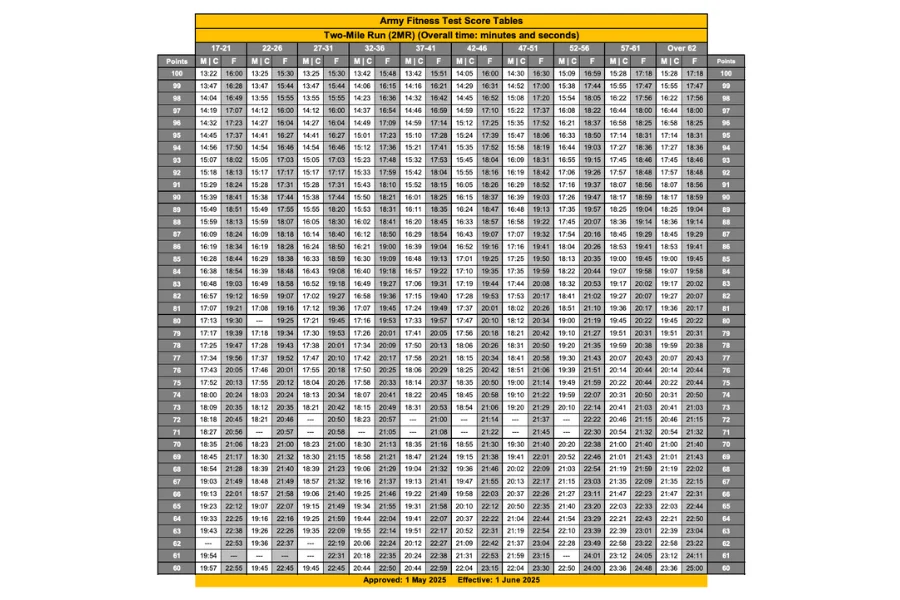
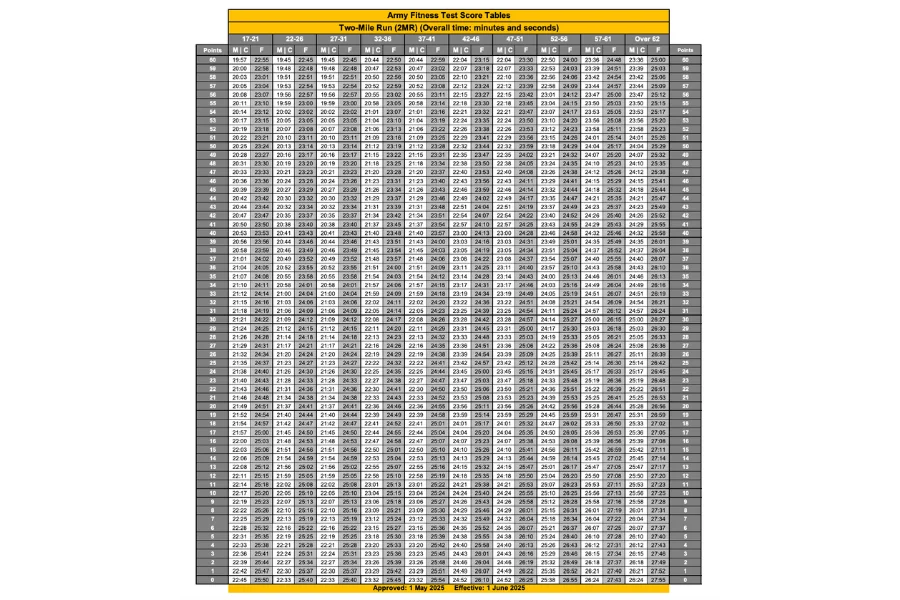
Requirements for courses
- You can complete the two-mile run on the following surfaces:
- A track that is indoors
- Tracks that are outdoors
- The surface of a road or sidewalk that has been improved
- Unimproved terrain cannot be tested with the 2MR
- It is important to note that the start and finish lines will be near the same location as the test sites for the other five events.
- Track courses may be run out-and-back or lapped
Implementation
- The soldier responded to the command “GO” by:
- Paces themselves as they run
- Defining two-mile course and completing it
- The athlete crosses the finish line, where their time is recorded
Soldiers may walk or stop for a moment during the exercise, but they should maintain a continuous pace throughout.
Military Careers and ACFT Scores
Every aspect of your performance is evaluated in the military, and physical fitness is no exception. The Army Combat Fitness Test (ACFT) demonstrates physical readiness and influences career progression directly. Taking the ACFT can help you advance your career within the military.
Promotion points based on ACFT scores
The ACFT isn’t only a test of strength, endurance, and agility; it’s also a measure of soldiers’ readiness for greater responsibilities. These scores are used by promotion boards to determine a soldier’s fitness for advancement and suitability for advancement. Your promotion point tally can be significantly enhanced by achieving high scores on the ACFT, thereby increasing your chances of promotion. Although passing a test might keep you in good standing, excelling can set you apart from your competition.
Points in the ACFT are calculated based on how you perform relative to others, emphasizing the significance of exceeding the standard requirements. During promotions, scoring above the 90th percentile in your age and gender category can enhance your profile.
Career Advancement: Targeting Optimal Scores
The following tips will help you achieve high ACFT scores that reflect your commitment to physical excellence and career advancement:
Customized Training Plans: By understanding your current physical strengths and weaknesses, you can tailor your training to improve your ACFT performance. Get a fitness regimen that addresses your specific needs developed by an ACFT-certified trainer.
It is important to focus on proper technique not only to prevent injuries, but also to ensure that you are performing each event as efficiently as possible. Simulated test conditions can help reduce stress and improve performance on test day.
The mental preparation for the ACFT is just as important as the physical preparation. Techniques such as visualization and mental rehearsal can help you feel more confident and perform better on test day.
Keep track of your progress through mock tests to understand where you stand and adjust your training accordingly. This is a great way to ensure your training goals are aligned with your targets.
Get support from your peers and commanders who are also preparing for the ACFT or who have excelled. Sharing tips, training together, and providing encouragement can boost morale and effectiveness.
Analyses and benchmarks of comparative effectiveness
When preparing for the Army Combat Fitness Test (ACFT), understanding what a ‘good’ score looks like and where you stand against the average can be informative and motivating. To help you set realistic and ambitious goals for your fitness and career advancement, we examine the average scores across different demographic groups, explaining what makes a good score on the ACFT.
How to define a ‘good’ ACFT score
Although ‘good’ can be subjective, when it comes to the ACFT, it is often defined by your goals within the Army, your age, and your role. Generally speaking, Military.com considers a score of 500 points or more ‘good’, which suggests that you are fit for promotion and specialized roles, not just meeting but exceeding the standard requirements.
Factors affecting ‘good’ scores include:
- A ‘good’ score differs based on age and gender categories, ensuring fairness across all groups and recognizing effort and achievement.
- As a result of the rigorous physical demands of their jobs, those in more physically demanding roles, such as combat arms, may be expected to receive a higher score.
Scores and benchmarks
In general, active-duty soldiers are expected to score between 450-500 points on the ACFT, depending on their age, gender, and specialty. By understanding the ACFT average scores, you will be able to customize your training and set performance goals accordingly.
Score Distribution Analysis:
- There is a tendency for younger soldiers to score higher, possibly due to their natural abilities in physical stamina and strength, but tailor-made training can assist soldiers as they age to maintain or even improve their fitness.
- A soldier in a combat role typically has higher scores because of the high physical demands of their jobs, while a soldier in a non combat role may see a wider range of scores due to the different physical demands of their jobs.
Data Utilization:
- For understanding where you rank relative to your peers, charts and tables displaying score distributions are invaluable. The visual aids can help you determine whether you are close to achieving ‘good’ or even ‘excellent’ scores and identify areas for improvement
Comparing ACFTs and standardized tests
Comparing the Army Combat Fitness Test (ACFT) to well-known standardized tests like the SAT provides a familiar framework for understanding and evaluating ACFT scores. There is a scoring system for both the ACFT and SAT to assess competence – the ACFT measures physical fitness, and the SAT measures academic readiness. Comparing these two seemingly different assessments will provide both soldiers and civilians with a unique perspective.
Comparison of ACFT and SAT scores
Military.com points out that both the ACFT and the SAT use a point scale to categorize performance. This comparison helps demystify the ACFT scores by aligning them with a more universal system.
The Scoring Scale and What It Represents:
- For each of the six events, the ACFT uses a 100-point scoring system, which mirrors that of the SAT, where each section is scored between 400 and 800 points, allowing a direct comparison of percentile performance.
- ACFT scores of 80 or above indicate a high level of physical fitness and readiness, just as SAT scores above 700 are considered “advanced,” indicating superior academic performance.
How to interpret the scores:
- Percentiles are used in both tests to indicate how a test taker’s score compares to that of others. An ACFT score of 90 percentile means that a soldier’s fitness level is higher than 90% of their peers, similar to an SAT score of 90 percentile
- Setting realistic and challenging goals is essential for both the SAT and ACFT. In the case of students, a high SAT score might be critical for admission to college, while in the case of soldiers, a high ACFT score could be crucial for promotion and special assignments.
Understanding scores in practice:
- Military training can be tailored to enhance specific physical areas that need improvement, much like students review their SAT scores to identify academic areas for improvement.
- You may wish to consider your ACFT score in comparison to academic tests if you are planning to pursue a military career. Knowing how your ACFT score compares to academic tests may serve as a motivational factor and context for your training program.
Performance and results of typical ACFTs
These results illustrate both the variability in scores as well as how physical attributes and training levels can affect performance on the ACFT:
| Height | Weight | Deadlift | Ball Throw | Hand-Release Push-ups | Sprint-Drag-Carry | Leg Tucks | 2-Mile Run | Total Score |
| 6’7″ | 245 lbs | 340 lbs | 11.5 m | 60 | 1:30 | 20 | 14:19 | 590 |
| – | – | 315 lbs | 9.2 m | 51 | 1:39 | 14 | 19:24 | – |
| 5’11” | – | 240 lbs | 6.7 m | 40 | 1:50 | 8 | 13:56 | 486 |
| – | – | 300 lbs | 10 m | 50 | 1:43 | 10 | 15:17 | 527 |
| 5’7″ | 165 lbs | 250 lbs | 6.9 m | 44 | 1:42 | 9 | 14:00 | 500 |
| 5’10” | – | 330 lbs | 10.2 m | 55 | 1:30 | 8 | 15:50 | 536 |
| 5’6″ | 195 lbs | 310 lbs | 7.6 m | 47 | 1:51 | 15 | 17:56 | – |
| 6 ft | – | 340 lbs | 11.5 m | 56 | 1:21 | Plank 3:40 | 13:30 | 592 |
It is important to note that the leg tuck event has been officially replaced by the plank in the most recent ACFT adaptations. However, the inclusion of leg tucks in historical data provides insights into how physical demands and evaluations have evolved over time. Planks were introduced so that core strength could be assessed without requiring additional upper body strength, making the test more accessible and achievable for a wider range of individuals. In addition to meeting the diverse needs of the modern army, these changes maintain the rigor required for combat readiness while maintaining fitness standards.
Conclusion
By the time we finish our exploration of the ACFT score chart, it’s clear that understanding these metrics is critical not just for meeting the standards, but for exceeding them while also advancing professionally. As an assessment of your readiness and commitment to the roles and challenges that will face you during your military career, the Army Combat Fitness Test goes beyond strength and stamina.
It is designed to serve as a guide for determining your physical training needs, as military.com explains, and to give you and your commanders a sense of your level of physical fitness. It is therefore essential that you not only participate in the test, but also engage with its results to tailor your training and development strategies accordingly.
Make sure your ACFT preparation is on track with our ACFT Calculator. We’ve created this tool to help you understand where you stand and what you need to work on. Get ready for the challenges ahead by improving your performance today.

